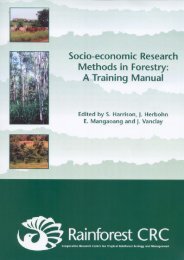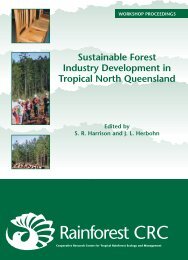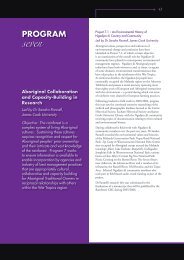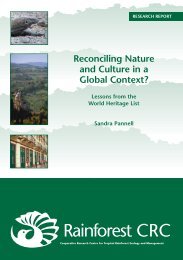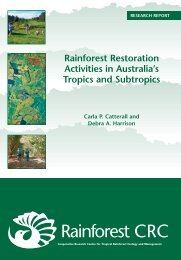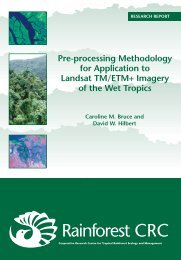Reconciling Nature and Culture in a Global Context? - Rainforest ...
Reconciling Nature and Culture in a Global Context? - Rainforest ...
Reconciling Nature and Culture in a Global Context? - Rainforest ...
You also want an ePaper? Increase the reach of your titles
YUMPU automatically turns print PDFs into web optimized ePapers that Google loves.
S<strong>and</strong>ra Pannellplace are different from the reason it is listed [for], <strong>and</strong> sometimes <strong>in</strong> conflict with it” (Sullivan2004: 52). Sullivan presents the example of the World Heritage property of Angkor, wherethe 1992 list<strong>in</strong>g <strong>and</strong> subsequent management plan ignored the social <strong>and</strong> contemporaryvalues regarded as of great importance to the local community. Indeed, as Sullivan reports,list<strong>in</strong>g of the property <strong>in</strong> terms of a ‘past civilisation’ denies the traditional <strong>and</strong> cont<strong>in</strong>u<strong>in</strong>g l<strong>in</strong>ksthe local community has with the complex (see Sullivan 2004: 50, 52). Sullivan’s commentshighlight one of the other dualistic tensions associated with many World Heritage properties.That is, the relationship between universal <strong>and</strong> local values. All too often, as the examplescited here <strong>in</strong>dicate, global culture displaces local culture. In the global diffusion of WorldHeritage-related values, the values local people attach to listed properties are either notacknowledged or are regarded as an obstacle to management. As the previously-citedexamples of the Wet Tropics <strong>and</strong> Komodo National Park illustrate, the very nom<strong>in</strong>ation of anarea for its natural values creates a space which necessarily excludes society <strong>and</strong> culture.Moreover, as the Military Fortress of Suomenl<strong>in</strong>na <strong>and</strong> the Historic Centre of Macauhighlight, history is also effaced <strong>in</strong> this displacement of the local by the global. Not only islocal history purged of its darker moments or even erased <strong>in</strong> this process, but it is also thecase that the world’s history is reconstructed <strong>and</strong> reworked to tell the <strong>in</strong>ternational story ofthe World Heritage List.HISTORIC CENTRES ON THE WORLD HERITAGE LIST:RESTORING AND REBUILDING WHAT?In many World Heritage ‘historic centres’, such as Macau, where the past has been restored<strong>and</strong> preserved as an enclave of colourful, colonial build<strong>in</strong>gs, the issue of exclusion relates tomemory, the politics of forgett<strong>in</strong>g <strong>and</strong> the creation of a collective amnesia. As the recentrebuild<strong>in</strong>g of Dresden’s Frauenkirche dramatically illustrates, the restoration of the builtenvironment damaged as a result of war, or other acts of communal violence, can also beseen, somewhat paradoxically, as the destruction of memory. In the case of Frauenkirche,reduced to rubble by Allied bombers <strong>in</strong> early 1945, the post-war response to the issue ofwhat to do with these ru<strong>in</strong>s was quite varied. As Jacob po<strong>in</strong>ts out, “East Germany’scommunist leaders were reluctant to restore a build<strong>in</strong>g identified with values contrary to theirown” (2005: 18). Some local councillors wanted to remove the rubble to make way foroffices <strong>and</strong> new public structures. Many <strong>in</strong> the community believed that it was “better toleave the ru<strong>in</strong>s untouched [as] a last<strong>in</strong>g rem<strong>in</strong>der of the terrible bomb<strong>in</strong>g raid” (loc. cit.). Withthe decision taken <strong>in</strong> 1990 to rebuild the church, f<strong>in</strong>ancial contributions from Brita<strong>in</strong> to assistthe restoration work were seen by some as an attempt to efface the memory of the raids,while others saw the donations as a sign of reconciliation (Jacobs 2005: 18).A similar situation to Dresden’s Frauenkirche existed with the World Heritage-listed, HistoricTown of Mostar, <strong>in</strong> Bosnia <strong>and</strong> Herzegov<strong>in</strong>a. Most of the Historic Town <strong>and</strong> the old bridge ofStari Most were destroyed <strong>in</strong> the 1990 conflict. The bridge was recently rebuilt <strong>and</strong> many ofthe edifices <strong>in</strong> the old town have been restored or rebuilt with the contribution of an<strong>in</strong>ternational scientific committee established by UNESCO. Like Dresden’s Frauenkirche, thereconstruction of Mostar is heralded by some as a “symbol of reconciliation, <strong>in</strong>ternationalcooperation <strong>and</strong> of the coexistence of diverse cultural, ethnic <strong>and</strong> religious communities”(UNESCO World Heritage website).The destruction of historic places <strong>and</strong> the desecration of sacred spaces are often seen as<strong>in</strong>evitable outcomes of war. For example, Liisa Malkki observes that throughout the‘mythico-historical’ accounts of her Hutu <strong>in</strong>formants, <strong>and</strong> <strong>in</strong> media reports of later violence <strong>in</strong>Burundi <strong>in</strong> 1993, there are numerous reports of violations to “the most holy <strong>and</strong> valuedplaces” (1995: 292). The violence that Malkki records aga<strong>in</strong>st these sacred <strong>and</strong> reveredspaces is also reported <strong>in</strong> a number of the regional conflicts <strong>in</strong> Indonesia. In the first twoweeks of the conflict <strong>in</strong> Maluku, for example, 23 mosques <strong>and</strong> 16 churches, <strong>in</strong>clud<strong>in</strong>g the56




